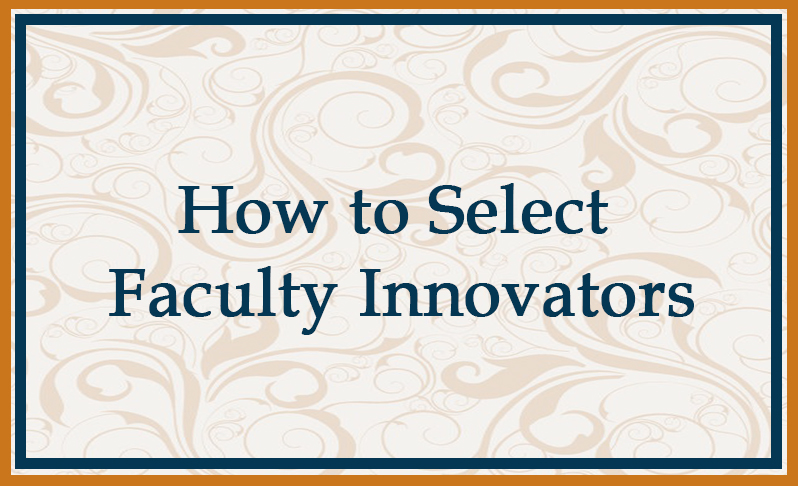For the past few posts, we’ve been discussing Faculty Innovators, those selected faculty members who bring development to the campus. An interesting question involves how they are selected. After all, they don’t fall out of trees.
Remember the 1989 movie Field of Dreams where Kevin Costner hears the whispering, “If you build it, he will come”? Centers of Teaching & Learning (CTLs) have enjoyed a similar phenomenon. If you build a teaching and learning center, faculty will show—too few of them. However, those few who show up for every event and try to enroll in every professional learning community (PLC) will be dedicated, and it’s from this cream you can find a few good people.
In short, in the beginning, choosing Faculty Innovators is almost a self-selecting process. A CTL wants to recruit faculty who are passionate about pedagogy, and what better litmus test than participation in CTL events?
Related Reading: Behind the Scenes with The Wizards Behind the Faculty Innovators
Our selection process has two stages. For the first two years of our Faculty Innovator program, stage one, we wanted the absolute best, most interested faculty—that is, we wanted to select those who have been selecting us. We have been building this program on the fly, and we didn’t want to stop to create a selection rubric, nor did we want to have to spend the time in the beginning dealing with faculty who had not shown a previous interest in development.
One way we recruited was to look back through our events for recurring participants. Of course, some faces stood out because we had worked closely with them and had gotten to know them well. Years ago, for instance, we ran a Learning Environment for Academia’s Future (LEAF) program, wherein we brought faculty in during the summer to an experimental classroom and trained them in its technology as well as best pedagogical practices. The next semester we had these LEAF fellows teach a class in this classroom, we observed them several times, and we conferenced with them afterwards. We also met with them at various times during the year as part of a PLC. One of our first choices was a graduate of this program who had actually published an article about LEAF.
Another choice had come to us with an idea for a PLC on cultural competency. With our help he had even developed a book proposal on this subject that was eventually picked up by New Forums. A third selection had not only run PLCs for us on metacognition and deep learning, but was his department’s pedagogical coordinator. Still another ran the Women and Gender Studies program and, since she once had had an office next to us, we had mentored. Another choice had offered to run a PLC for us, while another had not only attended many sessions and facilitated a PLC, but dwelt in a college on the other side of the campus. Years ago another colleague had worked with us on the Quality Enhancement Program as a coach. As she was retiring at the end of this year, she said she would meet with the Innovators and consult with her dean on her replacement, who then joined us this year.
Related Reading: Faculty Innovators: The Key to the Future of Faculty Development
Our plan, then, is not to use a formal selection process for this year and the next. After all, we are still ironing out the creases. In the meantime, the Executive Committee with input from the current FIs is developing a selection rubric for stage two that we ought to be implementing about this time next year. When done, the process will call for interested applicants to apply online, have their applications read by the current FIs, and be chosen by April. Each year during Scholarship Week (held the second week in April), we present the upcoming FIs to the university at large.
So far our embryonic rubric has produced a few standards:
- At least one FI must be from each of the five colleges. Because it is the largest on campus, the College of Arts and Sciences needs two Faculty Innovators.
- Applicants who have volunteered to facilitate PLCs or present workshops and have demonstrated excellence will be given preference.
- Preference will be accorded those with pedagogical experience—e.g., teaching such a course, serving as departmental pedagogy coordinator, or attending/presenting at pedagogical conferences like the Lilly or our own Pedagogicon.
- Preference will be given to applicants who have won departmental, college, university, or even state/national awards for teaching.
In short, we’re looking for leaders, alphas, people with initiative.
If you’re interested in our public website on the Faculty Innovators program, check out http://studio.eku.edu/facultyinnovators.
Author
 Dr. Russell Carpenter is director of the Noel Studio for Academic Creativity and Program Director of the Minor in Applied Creative Thinking at Eastern Kentucky University. He is also Assistant Professor of English. Dr. Carpenter has published on the topic of creative thinking, among other areas, including two texts by New Forums Press. In addition, he has taught courses in creative thinking in EKU’s Minor in Applied Creative Thinking, which was featured in the New York Times in February 2014. Meet Russell.
Dr. Russell Carpenter is director of the Noel Studio for Academic Creativity and Program Director of the Minor in Applied Creative Thinking at Eastern Kentucky University. He is also Assistant Professor of English. Dr. Carpenter has published on the topic of creative thinking, among other areas, including two texts by New Forums Press. In addition, he has taught courses in creative thinking in EKU’s Minor in Applied Creative Thinking, which was featured in the New York Times in February 2014. Meet Russell.



